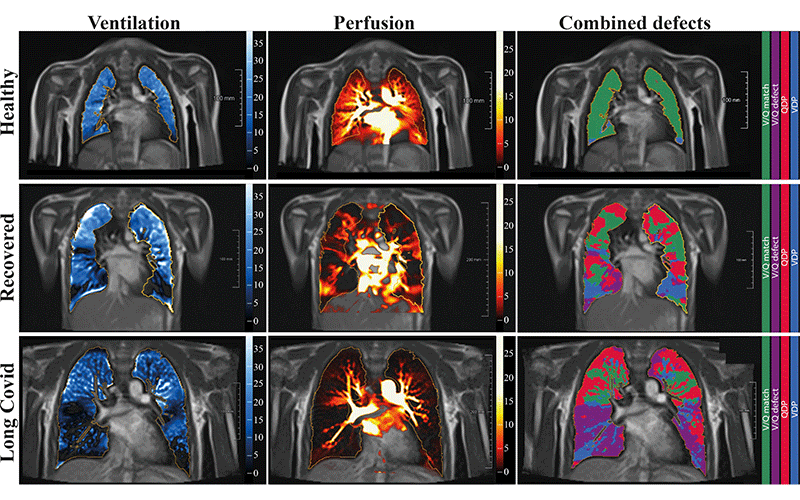Lasting Lung Damage Seen in Children and Teens after COVID
Study uses low-field MRI to evaluate long-term effects of infection

Children and adolescents who have either recovered from COVID-19 or have long COVID show persistent lung damage on MRI, according to a study published in Radiology.
Study of the disease’s long-term effects has accelerated as the number of COVID survivors climbs and more people are diagnosed with long COVID. The World Health Organization defines long COVID as involving symptoms that persist for a minimum of 12 weeks and other factors, such as symptoms that result in a new health limitation or worsening of a pre-existing underlying medical condition.
The nature of the post-acute phase of the infection is poorly understood in younger people. CT has shown persistent damage to the lungs in adults, but CT uses ionizing radiation and has limited diagnostic value in children, where lung changes due to COVID-19 are less pronounced.
“We conceived this study when the evidence for long- or post-COVID cases in adults was growing,” said study senior author Ferdinand Knieling, MD, specialist in pediatrics and adolescent medicine from the Departments of Pediatrics and Adolescent Medicine at University Hospital Erlangen in Germany. “This was also when the first patients with unspecific symptoms were seen in our department and parents started to ask about an association with a prior infection.”
Dr. Knieling and colleagues studied COVID-19’s effects in children and adolescents using low-field MRI.
“As parents, we also wanted to find what risks an infection might have,” Dr. Knieling said. “Luckily, our departments teamed up to use their brand-new MRI scanner designed for investigations in children and adolescents.”
Persistent Symptoms Make Long-Term Care a Multidisciplinary Challenge
The researchers looked at changes in lung structure and function in 54 children and adolescents (mean age 11 years) with previous SARS-CoV-2 infection. Of the 54 patients, 29 had recovered, and 25 had long COVID. All but one of the patients had been unvaccinated at the time of original infection.

Free-breathing phase-resolved functional lung (PREFUL) low-field MRI at 0.55T with calculated parameters at an axial plane after automatic registration to a mid-expiration position and lung parenchyma segmentation. From left to right, representative color-coded images of functional show ventilation defects (VDP, blue), perfusion defects (QDP, red), ventilation/perfusion (V/Q match, green), ventilation/perfusion defects (V/Q defect, purple) in a healthy control (upper row, 7-year-old male), a participant recovered from COVID-19 (middle row, 10-year-old male) and a participant with long COVID (15-year-old male).
https://doi.org/10.1148/radiol.221250 © RSNA 2022
None of the COVID-19 group required hospital admission during the primary infection period. Shortness of breath, impaired attention, headache, fatigue and loss of smell were the most commonly reported symptoms at the time of the study. Results from the COVID-19 group were compared with those from nine healthy controls.
MRI allowed the researchers to derive the V/Q match, a measure of air and blood flow in the lungs.
V/Q matches showed persistent pulmonary dysfunction in the patients who had recovered from COVID-19 and in those with long COVID. The V/Q match was 62% in the recovered group and 60% in the long COVID group—both considerably lower than the 81% match in healthy controls.
“Persistent symptoms after COVID still cause diagnostic odysseys, and this is especially true for young people,” Dr. Knieling said. “Our findings illustrate that caring for these patients is a multidisciplinary challenge.”
Long-term implications of these lung changes remain unclear, but the results warrant further surveillance of persistent lung damage in children and adolescents after COVID-19, Dr. Knieling said. Lung MRI is already widely available, he noted, making these imaging approaches easy to integrate into clinical routine care. More research will help show the full potential of MRI in COVID-19 survivors.
“A follow-up trial has already started and we seek to understand how findings change over time,” Dr. Knieling said. “Additionally, we will take closer looks at other organs to see how this correlates with our findings.”
For More Information
Read the Radiology study, “Pulmonary Dysfunction after Pediatric COVID-19.”
Read previous RSNA News stories about COVID-19:
- Study Tracks Key Imaging Features of COVID-19-Related Abdominal Inflammation in Children
- MRI Finds Lung Abnormalities in Non-Hospitalized Long COVID Patients